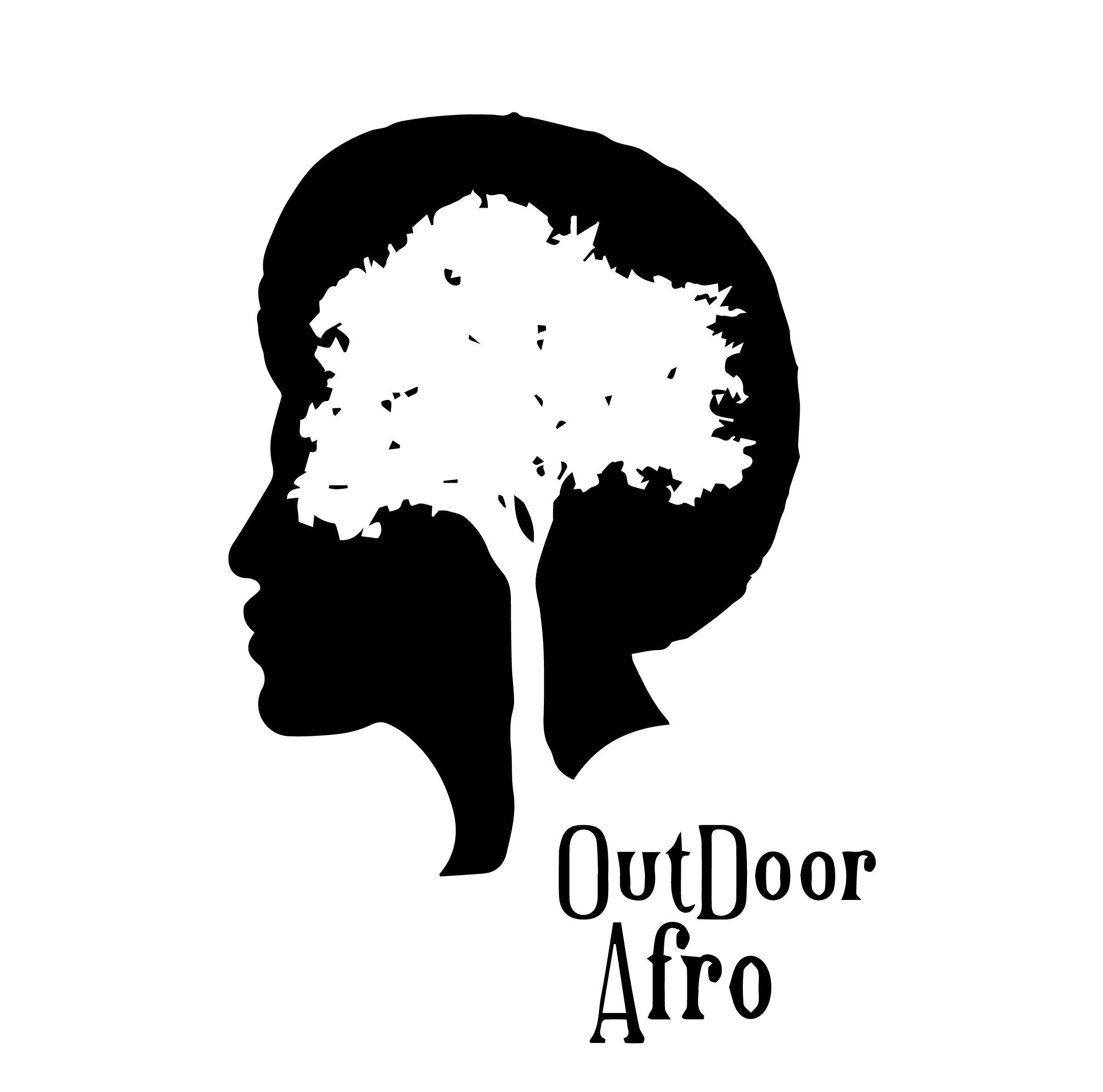An Outdoor Afro Remembers a Visit to Birmingham
My name is Nkrumah Frazier. I am a member of the Outdoor Afro Leadership team. Recently I was perusing some older pictures on my computer and stumbled across some pictures taken back in July of 2007 when my wife (Chelsea) and I reluctantly dropped our kids off at my mother’s house and hit the road headed to Birmingham, AL. We did not have a weekend worth of activities, sites and destinations already planned out. We had only decided to go a few days prior. I won’t attempt to talk about everything that we did on the trip rather I’ll highlight the things that were the most memorable for me. With this month being Black History Month I thought that it would be rather poignant to write about this experience.
On the way to Birmingham we stopped just south of Tuscaloosa, AL at Moundville Archeological Park.  The Moundville site was once a settlement of Mississippian Indians on the Black Warrior River in central Alabama. At its most glorious, Moundville was a three hundred acre village built on a bluff overlooking the river. It was once a populous town, as well as a political center and a religious center. In size and complexity Moundville was second only to the Cahokia site in Illinois.
The Moundville site was once a settlement of Mississippian Indians on the Black Warrior River in central Alabama. At its most glorious, Moundville was a three hundred acre village built on a bluff overlooking the river. It was once a populous town, as well as a political center and a religious center. In size and complexity Moundville was second only to the Cahokia site in Illinois.
Moundville has been well taken care of over the years and was a really cool place to visit. There was an added bonus in the form of a series of nature trails in the form of raised boardwalks through the forests and overlooking the river surrounding the raised mounds. We made our way through the walkways soaking up all that the Alabama wilderness had to offer or as much as could be gleamed from the completely unnatural boardwalks jutting out from the landscape. Regardless of how unnatural the boardwalks were they were well done and lent themselves to a really wonderful time.
Alabama is a land of large beautiful rolling hills. We stopped at a site overlooking a river that displayed some of those beautiful hills and the awesome power that water is capable of producing. From there we drove on in to Birmingham. We found and visited the Vulcan statue; the largest cast iron statue in the world and city symbol of Birmingham. The statue reflects the city’s roots in the iron and steel industry. The 56-foot tall statue depicts the Roman god Vulcan, god of the fire and forge. It was created as Birmingham's entry for the Louisiana Purchase Exposition (1904 World's Fair) in St. Louis, Missouri. It is the seventh-tallest free-standing statue in the United States.
That evening we heard on the radio that the Ebony Black Family Reunion Tour just happened to be Birmingham that weekend. The event was emceed by Tom Joyner Morning Show’s Ms. Dupree. We were blessed to see performances from the likes of Cupid (at the time his song “Cupid Shuffle” was just hitting the airwaves, but we knew nothing about him), Glenn Lewis, Cherrelle, MC Lyte and Whodini free of charge.  It was a delight getting to see Cherrelle perform after growing up listening to her songs on the radio. At one point she was joined on stage by a young girl of about 8 or 9 from the audience. She talked about and displayed the not so subtle differences in the way the youth of today dance and the way it was done “back in the day”. The young girl danced her heart out and once she was finished Cherrelle attempted to show and explain to the girl and the audience that you don’t have to work so hard when you dance. She said that the way that girls and young ladies bounce and gyrate really hard and fast isn’t necessary. All that’s needed is a subtle and gentle swaying of the hips in tune with the music to achieve the desired effect!
It was a delight getting to see Cherrelle perform after growing up listening to her songs on the radio. At one point she was joined on stage by a young girl of about 8 or 9 from the audience. She talked about and displayed the not so subtle differences in the way the youth of today dance and the way it was done “back in the day”. The young girl danced her heart out and once she was finished Cherrelle attempted to show and explain to the girl and the audience that you don’t have to work so hard when you dance. She said that the way that girls and young ladies bounce and gyrate really hard and fast isn’t necessary. All that’s needed is a subtle and gentle swaying of the hips in tune with the music to achieve the desired effect! 
MC Lyte then took full control of the stage. She came out and put on a display of lyrical prowess, stage presence and hip hop history that the overwhelming majority of the wanna be MCs on the radio today dream that they had and left the audience begging for more. Afterwards, Whodini stepped on stage and tore the proverbial roof off. I don’t feel I need to say anything else about that part of the show because, well…… it was Whodini! For the young people that may read this and wonder who Whodini is; I suggest you go and do a little research and then re-read this part of the story. Growing up poor in rural south Mississippi I was always behind the times when it came to music. Even the radio stations always seemed to be a little behind when it came to playing the latest music. Large musical acts never came to south Mississippi and even if they did I would not have been allowed to go. This concert to me was the embodiment of my childhood love of hip hop that I never got to experience and I’m thankful that I had this opportunity to see some of the greats of the business.
The next morning Chelsea and I woke up and wanted to do a bit more sightseeing before heading home. Chelsea being the history buff had a surprise in store for me. She wanted to see the famed Sixteenth Street Baptist Church. We drove around until we found the church, parked our car got out and walked the grounds. The Sixteenth Street Baptist Church was organized as the first black church to organize in Birmingham in 1873. During the civil rights movement of the 1960s, the church served as an organizational headquarters, site of mass meetings and rallying point for blacks protesting racism in Birmingham and throughout the South. On Sunday, September 15, 1963, members of the Ku Klux Klan bombed the church killing four young girls–Addie Mae Collins, Carole Robertson, Cynthia Wesley and Denise McNair–and injuring 22 others.
Adjacent to the church is a memorial park. This park was a memorial to the first the first American sailor killed in World War I, Mr. Osmond Kelly Ingram. In this park are statues commemorating the sights, sounds and activities of the civil rights movement in Birmingham. There were scenes portraying young black men and women being suppressed. One particular statue was of a young man being “arrested” by a policeman while simultaneously a police dog appears to be ready to bite down into this young man’s flesh.
Another set of statues consisted of police dogs in the act of lunging and barking at an “assailant” on either side of the circular walkway portraying a scene in which the dogs are attacking an invisible assailant standing on the walkway. I walked and stood in the middle of the statue and felt in awe of the power and majesty of the dogs that the statue is portraying. Immediately I began to try to imagine the fear that would undoubtedly arise within me if I were to be put in this situation with live dogs in real life.
There was a set of sculptures portraying a boy and girl being blasted by a water cannon. The sculptures of the boy and girl seem to portray the emotion that must have been experienced during such an event. Other sculptures include one of Dr. Martin Luther King and one of 3 preachers kneeling in prayer; a near by plaque reads “Place of Revolution and Reconciliation”. After leaving this memorial park we got back in our car and started the journey home. On the outskirts of town we looked back to see the Vulcan statue towering over the city bidding us adieu.
Having grown up in south Mississippi, I remember going to stores that wouldn’t allow black people to use the restroom. I remember hearing the “N” word being used in a very derogatory manner. I’ve heard stories and actually seen how ugly hatred based simply on the color of a person’s skin can really be. I remember thinking about the struggles that took place so that I’d be afforded the opportunity to walk among a memorial depicting this not so pretty side of human nature rather than having to live it first hand. I can’t help but think that the younger generations really don’t have a clue what it was like during those struggles.
For that reason I’m proud to be an Outdoor Afro. I’m proud to be an ambassador for my people. I am proud to be a part of the effort to reconnect; and in some cases to connect, black people to the natural world. But in some ways this effort is about more than just connecting black people to nature. This is about removing some of the misunderstanding, the misconceptions that some individuals have about black people. This organization serves to point out that black people are after all just people and in that light Outdoor Afro serves to bring us all closer together by showing us that we are all relatively the same. After all; the conversation we are attempting to have is merely a focused conversation; not an exclusive one.
Additional photos from this trip can be viewed in the Facebook album that was created.
Falling in Love with Lassen!

Lassen Volcanic Park continues to be the hidden gem enjoyed by the Outdoor Afro community. For the second year in a row, we partnered with National Park Service staff to lead a snow shoe walk among in the park’s beautiful red fir forest and for the second year in a row, we had a blast!
When we first arrived, Rangers Chris and Caitlin greeted us and explained the history of snow shoeing, including their use in Native American culture.
After all of us were fitted with our snow shoes, we made our decent in the wilderness where we learned about how the forest’s inhabitants survive in the winter and what humans can learn from them.

For example, Ranger Chris talked about the incredible memories of Steller Jays and Clarks Nutcrackers, who can store their food in several places throughout the season and remember where to find to find it when they return in the winter. All of us felt a sense of awe and warmth learning that we were in the park during the time that Black Bears were giving birth in their dens. In addition, we learned about the Sierra Nevada Snow Shoe hare, which changes its fur from brown to white to camouflage itself in the winter and relies on its large feet to keep from sinking in the deep snow.
There were so many memorable moments during the one and half hours that we all spent together, including shared stories, supporting hands, jokes and a few graceful falls. While the wind picked up from time to time, we were energized and warmed by each other and gave and received smiles throughout the hike. 
One aspect that I will never forget is the enthusiasm of Al, an Outdoor Afro from Tracey. While we were on the snow shoe, he saw a large hill in the distance that he wanted to ascend. While some of us wanted to conserve our energy for the return trek back to the visitor center, Al led a small delegation to the top of that peak. By the look on his face, you can tell he enjoyed that little jaunt!
Before we returned to the visitor center, the Rangers showed us some snow caves that had been dug by some of the school groups that had visited Lassen Volcanic Park. Snow caves are equal parts tunnel and holes dug in the snow for shelter and warmth. Here’s our adventurous Al again checking out the wintry accommodations

For me, the most surprising lesson learned was that Lassen Park, despite being one of the oldest parks in the country is also one of least visited. I encourage more people to take advantage of all the park has to offer. First, on the drive to Lassen, you are treated with an absolutely breathtaking view of Mount Shasta. Moreover, the park offers so much in terms of activity. In addition to snow shoeing, we enjoyed the cross country skiing, sledding and the beautiful and information filled visitor center. Not only were we impressed by the beauty of the forest, we also admired all of the volcanic peaks surrounding the visitor center including Brokeoff Volcano and Prospect Peak. The Rangers invited our group back during the summer for the Lassen Dark Sky festival which will include nightly constellation tours and stargazing. Its just one of the many great reasons to visit the park during any season.
Thanks so much to the Lassen Volcanic Park staff for preserving this sacred space. And special thanks to all of the Outdoor Afros who made this trip so enjoyable!

When Camping Goes Wrong
Sometimes things just don’t go according to the plan.
You can buy or borrow almost any product that adapts to an outdoor lifestyle and experience, but sometimes oversight, lack of experience, or unexpected weather conditions can cause the best laid camping plans to run afoul.
Like forgetting a can opener when camp meals depend on canned goods or arriving at camp to find the tent poles never made it into the car, and heaven forbid there is no wine or bottle opener!
I’ve lived through a few camping mishaps of my own.

For example, I can now (after 20 years) fondly recall a car camping trip along the California coast with my University Women’s Center staff back in college when I was 19. We were so determined to do the trip – women can and will do anything was our internal motivating mantra. And in the face of an incoming storm, a little predicted rain and cold was not going to stop us!
The day of our trip, I dug out and threw my 2-person hand-me-down day tent and sleeping bag into the car. Our group stopped at a Safeway along the way where we impulsively filed our basket with every comfort food and drink we could find.
By the time we reached camp with our bags of groceries, it was late afternoon, and light rain had begun to fall. I do remember how beautiful the redwoods were, filtering rays of sunlight on our camp.

But the rain picked up toward the evening, extinguishing our fledgling fire. The air chilled in character and on queue for the region. So an early retreat to our tents was the best option– or so I thought, until I discovered my tent had a small leak.
I managed to plug the hole with tape, and rearrange my belongings and sleeping bag away from the moisture, forcing me to curl up on one side of the tent.
I knew it was going to be a long night.
After drifting off to sleep for a few hours, I woke to the sound of pouring rain and a soaked sleeping bag. Now, my tent was leaking all over, and without a tarp beneath me I felt moisture from the ground seeping in. All my earlier feminist bravado came to a screeching halt. I was wet, cold, and groggy. And as far as I was concerned, our camping trip had come to an end.
Thankfully, I've learned a lot since those early days of planning camping trips on my own as a young adult. Camping with my children over the years has necessarily sharpened my skills. I now make sure we have the right tools for the type and location of camping we do. Thinking back, I know that with some basic skills, research on where we were going; packing the right tent (tarps!), sleeping bag, and better layers of clothing, our camping trip would have been a more dry and cozy adventure versus a cold and wet one.

This is one reason the correct gear and the knowledge of when and how to use it matters. If you don’t have a camping role model in your friend or family network, many REI stores, and organizations like Outdoors Empowered Network are answering the call with free and low cost gear closets and technical assistance to help groups like my Women’s Center crew get camping right the first time so participants can look forward to participating again and again.
Has camping ever gone awry for you? How did you make the best of it? – Or did you roll up your sleeping bag and go home? Leave a comment and tell us!
Apply to Join the Outdoor Afro Leadership Team Today!
Do you have a passion for the outdoors and want to share it with others?
Consider applying to join the 2013 Outdoor Afro Leadership Team today!

In 2012, we successfully launched the volunteer Outdoor Afro Leadership Team of 13 folks - the OALT, who formed a team of "experience ambassadors" for Outdoor Afros all around the country. Between May and December of 2012, this team led 500 people to nature right in their own backyards, many for the first time, thanks to these inspiring outdoor role models and our generous sponsors! (see below!)
As you know, Outdoor Afro supports a vision of outdoor recreation and conservation engagement for everyone, especially for the African American community. At Outdoor Afro, we can provide leaders a platform and the support to help others reconnect to natural spaces right where they live. Leaders can learn to be a role model for camping, hiking, kayaking, birding, fishing -- or any other recreational activity to share with others.

We are specifically interested in leaders who can represent the New York, Washington DC, and Pacific Northwest regions, but members from all US metropolitan regions are welcome to apply!
Here is what we require:
- Facilitate 1-2 OA sponsored events every two months
- Contribute to blog entries and social media
- Participate in a monthly conference call with other OA Leaders
- Help to further the mission and exposure of OA throughout local communities
Leader perks include:
- Select FREE premium gear and supplies from sponsors KEEN Shoes, REI, and Clif Bar
- Professional support, coaching, and outdoor skills development opportunities
- The ability to make a tangible and positive difference for communities and the natural world
Apply now to join our diverse team from around the nation to bring the outdoors to more people in your community.
Next Steps to be Eligible for Consideration:
- Complete the application and submit via email by Friday February 22nd and participate fully in the interview process via video conference
- Be available for a mandatory in–person training from April 19-21 in Northern California
The 2013 Class of Outdoor Afro Leaders will be confirmed and announced in March, 2013.
For any questions please contact engage@outdoorafro.com
The Outdoor Afro Leadership Team is possible because of the generous support of:
Toyota Audubon Together Green
KEEN Shoes
Clif Bar
REI
The Golden Gate Audubon Society
Geocaching Your Way Through Black History
What exactly is Geocaching, you ask?
"Geocaching can be a fantastic way to spend some time outdoors, discovering and learning more about your world, in places both near and far, alone or with family and friends. It’s like treasure hunting, but the treasure is the experience."
Guest Blog by Cat Clark tells us more about it!
When the weather in the Washington, DC area is mild, it allows me to enjoy one of my favorite outdoor activities: Geocaching!
Geocaching is a kind of high-tech scavenger hunt. Participants use handheld GPS receivers to find hidden containers (geocaches) of varying sizes all over the world, sign the logbooks inside, and share their adventures on websites such as Geocaching.com. And geocachers hide caches everywhere-- from national parks to the city streets. Chances are good that you've passed within a few feet of several geocaches without ever realizing it. It's a fun, family-friendly way to spend some time outdoors wherever you are.
One of the things I love most about geocaching is that it's so much more than an outdoor game to play with family and friends. Geocaching leads me to amazing places I might not have otherwise visited or noticed. I've found caches in exquisitely beautiful small parks and in curious locations such as a mausoleum in a hotel parking lot (true story!). But some of my favorites are the ones that lead me to historic landmarks. Just recently, my geocaching adventures sent me to some local Black history sites.
The first cache was hidden near Ben's Chili Bowl in Washington, DC, the famed restaurant frequented by Duke Ellington, Miles Davis, Ella Fitzgerald, Cab Calloway, Nat King Cole, Redd Foxx, Dick Gregory, Martin Luther King Jr., Donny Hathaway, Roy Ayers, and Bill Cosby. During the riots that followed the assassination of Dr. King, Ben's was allowed to stay open after curfew to provide food and shelter for activists, firefighters, and other public servants. Visiting Ben's is a must for all DC tourists, and the food is fantastic. I'd eaten there before, but I was grateful that geocaching gave me yet another reason to grab a chili half smoke! The amazing history of Ben's Chili Bowl is summarized on Ben's website:
The second Black history cache I visited was at the home of educators and civil rights activists Dr. Edwin B. and Mary Ellen Henderson in Falls Church, Virginia. Dr. Henderson was the first African American to be certified to teach physical education and argued passionately for equal opportunities in thousands of editorials. Mrs. Henderson, an educator in Falls Church's segregated school, fought for 29 years to have a new school built for Black students. Falls Church's current middle school is named for her. The Henderson House was recently nominated to the National Historic Register of Historic Places and Virginia Landmarks Register. Check out the Henderson House on Waymarking.com
The third cache, very close to the Henderson House, was hidden at a granite arch I pass frequently in my car but had never stopped to investigate. It turned out to be a monument honoring the men and women of Tinner Hill. In 1915, local Black citizens-- led by Dr. Henderson (see above) and Joseph Tinner-- formed the Colored Citizens Protective League (CCPL) to fight housing segregation ordinances. This group became the first rural branch of the NAACP in the nation. You can read more about the inspiring monument and other local history sites on the Tinner Hill Heritage Foundation site.
Previous geocaching outings have taken me to the Freedmen's Cemetery and African American Heritage Park, the latter quite close to a beautiful sculpture of abolitionists Emily and Mary Edmonson, in Alexandria, Virginia.

Geocaching can be a fantastic way to spend some time outdoors, discovering and learning more about your world, in places both near and far, alone or with family and friends. It's like treasure hunting, but the treasure is the experience.
Want to give it a try? First, visit Geocaching.com to read Geocaching 101 and set up a free account. If you don't have a handheld GPS receiver but have a smartphone, some great geocaching apps are available. I'd also recommend investigating some online tutorials and tips posted by friendly geocachers around the web, such as HeadHardHat's "Geocaching Basics and Geocass' "GeoCaching with the iPhone: Preserving Battery Life". Don't be intimidated, just start with some regular-sized, traditional geocaches with easy difficulty and terrain ratings (1 to 2 stars). After you've found a few caches, you will get the hang of it!
If you get hooked and you're thinking about investing in a handheld GPS receiver for geocaching and other outdoor activities, don't forget to ask about GPS navigation classes at outdoor sporting stores such as REI.
More interested in finding the history than the geocaches? There's another option for you! Visit Waymarking to get the coordinates for millions of interesting locations. Just plug in some keywords and a location and you can custom-design a tour you'd never imagined possible. Did you know about the Glen Echo Park Civil Rights Protest? You can visit the restored carousel yourself!
Happy hunting!
Cat Clark
Outdoor Afro Contributor for Black History Month
Outdoor Afro Wins Inspiration Award at Outdoor Retailer Show
What an amazing week! Just got back from Outdoor Retailer Winter Market, the largest outdoor industry show in the country that occurs twice yearly in Salt Lake City, Utah.

In a proud and humble moment for Outdoor Afro, we received the Outdoor Industry Inspiration Award, presented by adidas Outdoor, in the company category pared down by industry vote from over fifty esteemed and well-established organizations, including our rockin' partner and supporter REI.
Check out the press release here.
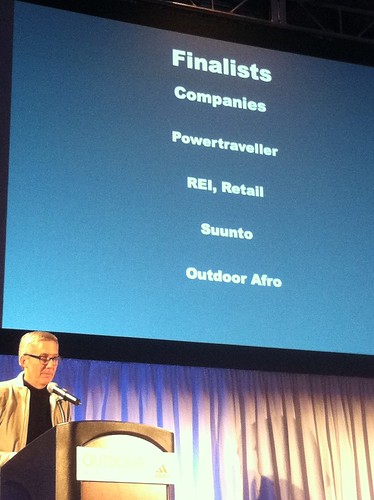
I feel the award is shared by all the people who make up the Outdoor Afro community of support, especially the Outdoor Afro Leadership Team who are getting people outdoors around the country to enjoy and conserve the natural world.
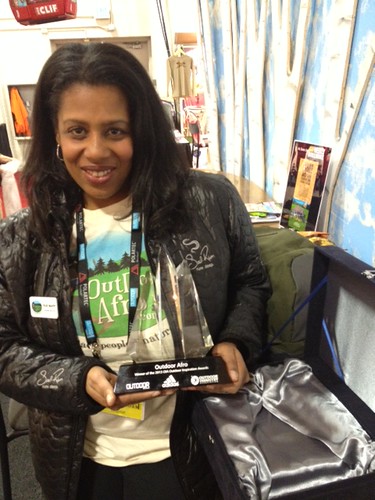
OR is the place for manufacturers to demonstrate and sell their newest wares to buyers and retail outlets. It also provides an important forum for education, networking, media, and professional recognition for brands and efforts that are making an impact in innovation, advocacy, and inspiration. For me, it brings so much satisfaction to be with friends old and new to imagine together how we can connect more people to the outdoors.
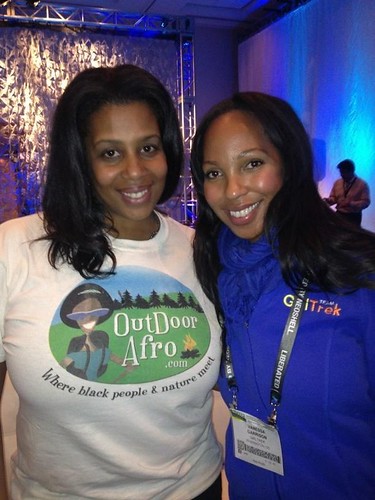
I also especially enjoyed rallying around the 2013 NOLS Expedition Denali team in a celebration of its new partnership with REI and The North Face,and had a blast with Outdoor Afro sponsors KEEN and Clif Bar!
Check out all our photos:

Oh - and look who I ran into on the plane ride back to Oakland - Talib Kweli!

Like I said...an amazing week! And I am re-energized about the fun work ahead!
Outdoor Afros and Audubon Come Together for King Holiday Conservation Fun
We are so proud and grateful to have spent another day with Northern California Outdoor Afros in partnership with Golden Gate Audubon. Together, we connected more people to our local natural assets to help preserve and enjoy them with others. It was such a perfect day. The warmth of the sun and people who attended made us all forget it was still winter.
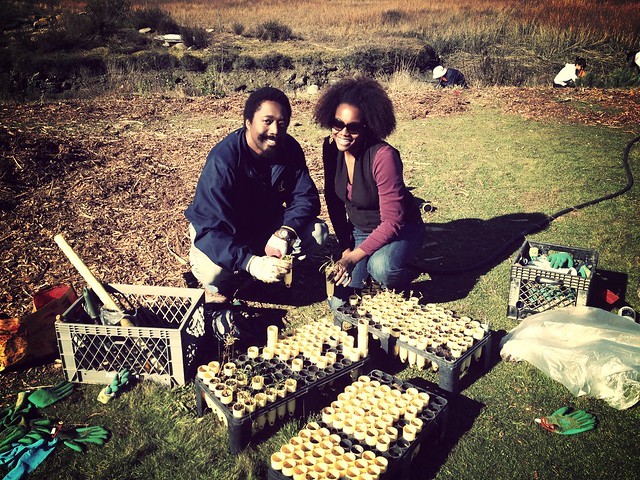
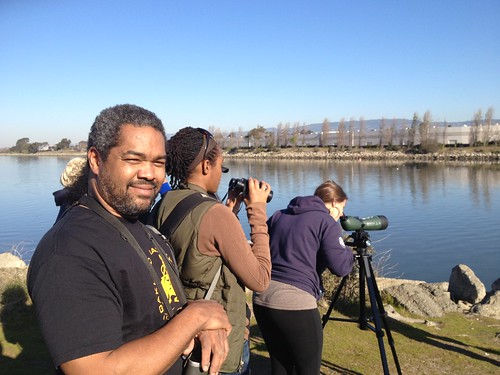
Thirty Outdoor Afros and fifty more attendees from Girls Inc., California Conservation Corps, with Golden Gate Audubon staff and interns descended on the Martin Luther King Jr. Shoreline with the support of the East Bay Regional Parks, to plant native trees and shrubs, identify local birds, and pick up trash along an important shoreline home to the endangered Clapper Rail among other wildlife, and the bustling human population of East Oakland just over the freeway. After a few hours of rotating activities, we enjoyed a picnic lunch, while the younger children played out their remaining energy.

Leslie Hardy Hood, an Outdoor Afro mother of two, and Oakland physician said, "Our family had a great time planting, birding and being with other like minded families!" Most in our group had never birded with binoculars, or participated in deliberate conservation activities in a preserve. Chanel of Oakland exclaimed, "I planted my first tree today...looking forward to future events!"
And so are we!
Thanks to our sponsors Toyota Audubon Together Green, REI, KEEN, Clif Bar, and Golden Gate Audubon for helping make the event a success - you all were the talk of the town for your inspiring presence and support!
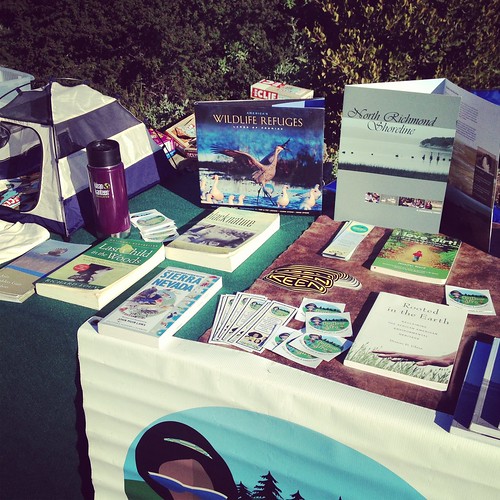
Winter Trails Day Was a Blast!
I am still tickled from our time this past weekend in the California Sierras as eleven Northern California Outdoor Afros participated in the annual Winter Trails Day by REI, coordinated by Outdoor Afro leader Rahman Batin and hosted by the co-op's Sacramento market.
This was a cross-promoted MeetUp of Outdoor Afro, designed to help people learn through easy and fun lessons and demonstrations how to snowshoe and cross country ski. Participants were also exposed to brands that can help make these experiences comfortable. I was especially stoked to see our sponsor KEEN Footwear represented to compliment snowshoeing. Check out our photos below!
In the week prior to our trip, I had to make sure my ever growing younger children and I had the right gear. So with the help of our friends at Bay Area Wilderness Training, The North Face, and KEEN Footwear, we were exceedingly prepared with everything we needed to stay warm and dry in the snow.
After rustling up sleepy folks on Saturday morning, and filing them into my trusty truck loaded with snacks and gas, we drove up without a hint of traffic before dawn. Joining me for the ride was my Cal alumna Barbara Henry and her daughter Emma, who had never been exposed to the snow. Admittedly, my own younger kids had never experienced snow play before, (yup, the children of Outdoor Afro) so this opportunity was a perfect chance to try on a new outdoor experience. See, in the San Francisco Bay Area, we have to go to the snow, therefore the pursuit is not without a tremendous commitment of time and cash for things such as gear foraging, lodging, transportation, lift tickets, trail passes, and more.

It is no surprise that unless you cultivate the interest and passion for snow play, especially at a young age, it may not be a high priority for people who have other, and more accessible, outdoor/nature or sports options available closer to home. This is why the REI event was so cool - it allowed moms like Barbara and myself, to try on new activities that ignited a passion in our family we now know can bring us back to the snow again and again!
One of many inspiring parts of the trip was how we got to see snow for the first time through our children's eyes. Many wide-eyed audible ooohs and ahhhs were heard from the back seat, as we climbed elevation with increasing snow visible on the side of the road along the highway, and caked on alpine branches and mountains.
3 of The Most Memorable Moments of our Trip:
1. Learning to cross country ski - It was a completely new experience for all of us, and we fell in love!
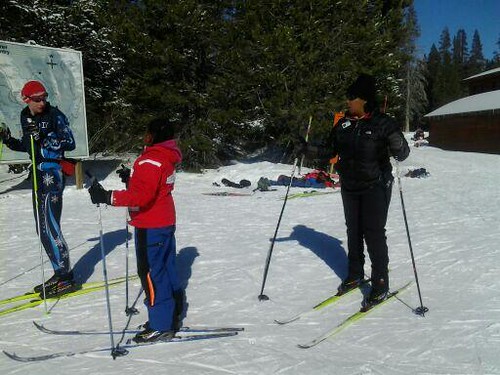
2. Observing wonder and passion - the children jumped into the snow as soon as they saw it and for five hours straight, never stopped enjoying it. It was so hard to leave!

3. The sunset on the drive home - it felt like one big validation banner for a perfect experience had by all.
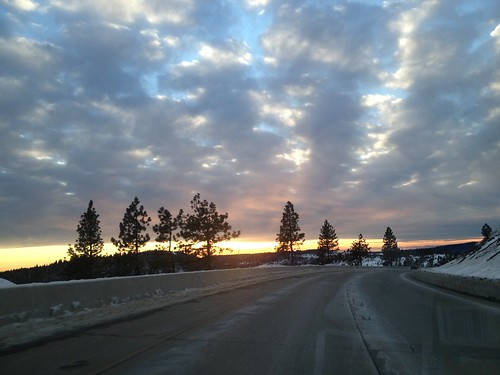
Thank you REI Sacramento Market, KEEN Footwear, The North Face, Bay Area Wilderness Training, Outdoor Afro Leader Rahman Batin, and Sacramento REI's Erin Harrington for coordinating the whole event - you all rock, and we will be back!
Do you play in the snow? How do you make it happen? What do you enjoy most about it?
Musings of an Urban Park Manager: A Black Male Reflection
Greetings Outdoor Afros:
I’m Morgan Powell and this is my fifth blog here at Outdoor Afro. I’m the founder of Bronx River Sankofa - a documentary series on Cable TV and Facebook featuring African-American environmentalists from New York City’s greenest borough. Many male Harlem Renaissance writers and other 20th century brothers-on-a-soap-box wrote about the invisible man phenomenon or mistaken identity in general stemming from low expectations by others of men of African descent. The playful piece you are about to read contrasts a photo-documentary of my busiest days when I was a manager to a public park with the historical writing I was doing out of view at that time. Among the many conversations with park users that prompts this blog was a conversation in which a well-meaning park volunteer told me she thought I was too smart for my job. Consider this a modern version of so many essays by figures like Langston Hughes, Ralph Ellison and James Baldwin by an emerging eco-writer. Please ponder parallels between my park and story with places and workers familiar to you as you read this meditation on the park and its regional context in New York City!

The soil and ground of and around Stuyvesant Cove is a regional resource. The park and neighboring Stuyvesant Town development are reclaimed from the East River which met the shore of Manhattan Island further inland along 1st Avenue before Western civilization reached the New World, reshaping the shoreline with landfill and structures built on pilings. A 19th century resident of the Stuyvesant Cove area, George N. Lawrence, recorded a glimpse of local natural history in 1889 published as “An Account of the Former Abundance of some Species of Birds on New York Island, at the Time of their Migration to the South.”

“When I was a schoolboy a favorite skating place was Stuyvesant Creek, a considerable body of water, which had its head quite close to the Third Avenue, about 20th Street, and it emptied into the East River—I think at about 12th Street. On the north side of it, there were high woods, where I have seen Robins pursued by gunners, when the ground was covered with snow and the creek frozen.”
Here we have a historical snapshot that includes a reference to a time of wild hydrological features in the landscape before public waterfront access was an issue. It continues - beyond the selection above - with a description of local bird populations in which their presence is painted so richly as to seem fantastic. But those who have lived in the Stuyvesant Town development adjacent to this park for more than a decade may remember a louder and more diverse seasonal bird community in years past. That was before suburban sprawl paved over yet more thousands of tracts of formerly natural habitats. Such places once supported our regional web of life as near as the neighboring county of Staten Island or as far as the Catskills region to the north. Thanks is owed to the groups of citizens who worked on the transformation of this post-industrial relic we now enjoy as Stuyvesant Cove Park which opened in 2002. Similar praise is worthy for those who helped acquire and restore other parcels of land in the greater New York area one acre at a time.
One plant at a time, we restore the habitat that wildlife need. Our trees provide shelter to migratory birds, but cool shade to strollers walking below them as well. Both hummingbirds, seen occasionally, and butterflies—among them the Great Swallowtail (Papilio cresphontes) and Monarch (Danaus plexippus)—feed on the nectar of park flowers. They come here for different types of blooms. The hummers prefer tubular shaped flowers like hibiscus, monarda, and trumpet vines that they can probe with their long beaks while hovering in mid-air. By comparison, the butterflies prefer to land atop flower platforms and walk about while sipping nectar. Such butterfly-attractive flowers can be found among the Cove’s asters, goldenrods and other North American native composite blossoms like echinacea. Each year, the plantings at Stuyvesant Cove include more species, making the park a better and better stopover habitat for these winged migrants. Woody plants, as well, play their role to recreate a welcome and familiar habitat amid the concrete jungle that is Manhattan island.
If we could have taken refuge in the local forest of the pre-modern period, what a forest we would have found! Most of the trees would have been oaks, hickories and tulip-poplar trees. Some of the tulip-poplars would have been almost 300 feet tall, taller than any trees we can find in New York City today. Among the prettiest migrant birds, both then and now, are the ones that depend on them. Some of these winged friends make the 2,000+ mile trip to Central and South America in autumn, and then back again each spring. These include the warblers who fuel their journey by feeding upon caterpillars. This food chain exists as just one of numerous life cycles vibrantly played out year round.
When winter temperatures turn East River water to ice on our local industrial relic, the rocky outcrop (at 20th St.) , we see another face of nature. Waterfowl appear there and on neighboring floating ice. Though the waters that lap along our granite bulkhead are not formally part of the park, we remain mindful of it as we hold to a non-toxic cleaning regime that minimally drains through them. Indeed, wetland grasses planted along portions of the bulkhead are our homage to the seamless connection between earth and water. This connection existed before modernity imposed his way. We know that worms in the soil have moved far below the surface and are safe from frost, assuring us that they will help us maintain a quality of growing medium for plants unseen in most urban parks. Much fruit from hardy shrubs such as gooseberry and roses lend color to our walks amid the elegant architecture of trees. Such living gems as red rose hips – faithful sights in cold and even snow – promise leaves and flowers in spring.

From 18th to 23rd Streets, we enjoy the Cove as a unique station along a network of waterfront parkland that is being rehabilitated within and surrounding our city. This network extends to points north and south of New York State forming the emerging East Coast Greenway. In winter and all seasons, we can depend on a steady program of public activities at the park’s museum of green living, Solar 1. Not unlike ancient English house museums that serve as points of departure or destination to amblers of national trails, Solar 1, the environmental classroom here, opens its doors to the public and shares the wisdom of ecology through the creative prism of the arts. As one of just a few sustainably managed public parks in this network, we serve as an example for new park designs from Maine to Florida. We may be known far and wide because our mission and accomplishments have been celebrated in print from the New York Times to design-trade media.
A Meditation on the Cove’s Air
Devotees of urban parks are doubly fortuned by nature’s compelling inspiration coupled by the convenience of designed spaces. We may gaze spectacular natural and man-made views often with benches, tables and restrooms nearby. Praise to urban living! One may marvel at the view from 20th Street in Manhattan, New York – all its glistening, moving water we call the East River – and recall or imagine more rustic settings beyond city limits.

How do air, water, and earth combine in the urban ecology? Waterfront parks provide space to wonder at the answers. Though city parks may seem somehow removed from our conceptions of the natural, an essay by Simon Shama offers us that “they are all the nature we ever had.” Let us be mindful that we humans are part of the web of life and have been agents of change in the local landscape and beyond since days much earlier than writings record. Let’s explore a few natural aspects of the park we love over time and in focus! Perhaps we will see that these Stuyvesant Cove Park’s 1.9 acres are integral to a community of life both locally and regionally.
Local air seems to be a regional resource. Ken Chambers of the American Museum of Natural History has written on birding here and celebrated his subjects as “the aristocracy of the air.” I think of birds mostly as natural soundtrack musicians.
The “tseep, tseep, tseep” calls of the warblers, orioles and their kin in summer bends our ears to the sounds of “traffic” along an ancient “highway.” It’s called the Atlantic Flyway. This Flyway is a continental swath of land and air that see heavy concentrations of winged migration among a wide range of bird species. Though no two migratory bird species follow exactly the same route, there are annual travel patterns between particular breeding grounds and wintering grounds for each species. I’ve asked myself often, “How large an airborne community passes over this land at the height of their season on the busiest nights?” Chambers and other birders have informed me a hundred birds might pass through per hour at peak times. Quiet and early mornings that follow such nights reward the visitor with glimpses of migrants having landed to rest and feed. We have seen warblers such as the American Redstart, with its black and red plumage feeding upon insects around the shrubs and larger perennials (i.e. grasses and milkweeds). We once saw an Ovenbird walking and foraging, making its loud “tea-Cher, tea-Cher, tea-Cher” call too. The night migrants, many thousands, even millions of them, pass over Manhattan on their journey north in spring and again on their way south in autumn. River valleys like ours along the great Hudson can be ideal for flyway routes. Over fifty-five species of birds, close to a dozen butterflies, and even a bat have been observed at this site in season.

We would also be wise to appreciate the air itself. Consider the heat island effect—that phenomenon wherein the dense infrastructure and intense human activity of cities create thermal halos, making a center city warmer than the suburbs that extend from it. Your and my conservation work helps restore the primordial balance within the blue-green world that predated so many highways, gas pipe networks, housing complexes, and miles of asphalt. Scientists at Cornell University and elsewhere are studying ways to mitigate the heat island effect by planting groves of trees in and around metropolitan areas. They are also using such groves to study the way trees clean the air with the removal of VOCs (volatile organic compounds) from the air we breathe. Fewer VOCs in the air mean healthier environments for people, especially the young, old and ill. By the way, these considerations may be yours should you repaint an interior environment because low VOC paints are popularly available on the retail market!
Our urban forests, inclusive of cherry trees and other key air cleansing species are, indeed, both cooling and cleaning all that we inhale. These woods – both modest as city vest pocket parks and grand as large destination ones – are valuable. Our care for them is our commitment to the good life.

“I love to think of nature as an unlimited broadcasting station, through which God speaks to us every hour, if we will only tune in.”
? George Washington Carver
My Favorite Parks to Visit and Write About
Antwerpen Parks, Antwerp, Belgium
Barcelona Botanic Garden, Spain
Battery Park City Parks Conservancy and Historic Battery Park, New York
Boerner Botanic Gardens, Wisconsin
Brooklyn Botanic Garden, New York
Chicago Botanic Garden, Illinois
The Cloisters, Metropolitan Museum of Art
The Commons, Boston, MA
The Conservatory Garden (of Central Park), New York
Crotona Park (Great example of depression-era WPA successes), New York

Devon House (estate museum and crafts market), Jamaica, West Indies
Flagler Museum & the Breakers (Hotel and golf club), Palm Beach, FL
Huntington Botanical Gardens, San Mareno, CA
Jardin Botanique de Montreal, Canada
Jardin Exotique de Monaco (famous for rare succulents and Riviera views), Monaco
Le Jardin et les serres d’Auteuil, Paris, France
Le Jardin de Plant, Paris
Lincoln Park Conservatory, Chicago, IL
Longwood Gardens, PA
Madison Square Park (19th century sculpture of), New York
Megeve (alpine forest of), France
NYC Historic House Trust
Old Port of Montreal, Canada
Planting Fields Arboretum, New York
Quaker Hill Native Plant Garden, New York
Real Jardin Botanico, Madrid, Spain
Rock Garden Park, New York
Royal Botanic Garden at Kew, Great Britain
Stuyvesant Square Park (19th century charm), New York
Staten Island Botanic Garden, New York
Ile de St. Marguerite, Nice, France
Vanderbilt Historic Site – FDR Presidential Library, Hyde Park, NY
Versailles Palace and Grounds, France
Woodlawn Cemetery (world famous for classical fine art and architecture), Bronx, NY

2012: An Amazing Year!

As many of you know, this year marks a big transition as I fully embraced Outdoor Afro as an important part of my purpose, and since, the quality of my life has improved as it allows me to spend more time enjoying my family, and nature! But beyond the scope of my personal life, for me Outdoor Afro represents a chance to help make a positive difference for the world, and I am grateful for each friend and colleague who believed in this vision and cheered me on.

Now for some highlights of 2012
In May, we received our first grant from Toyota Audubon Together Green, and launched the first class of the Outdoor Afro Leadership Team (OALT) that reflected each region in the US. These leaders, hailing from diverse backgrounds, helped get more than 500 Outdoor Afros off the couch and into the outdoors. I am grateful and proud of them, and aim to help this team grow and continue to succeed in 2013. Check out our current Indiegogo campaign and Chicago OALT leader Viva Ama's reason for being on the team:
Outdoor Afro was humbled by the tremendous media recognition this year, including ABC, CBS, and Backpacker Magazine. I was especially floored, and a little more than tickled to make The Root 100, where I was recognized as one the most influential African Americans in the country and later to receive a humanitarian award by Hidden Villa Ranch. Each of these moments helped to push the message that black people do have a relationship to the outdoors, and show the ways we each can take meaningful action that gets more people connected to nature.

We are sustained by the many partnerships we have formed since Outdoor Afro began, and thrilled about our new corporate partners, KEEN footwear, REI, and Clif Bar. I have also enjoyed working on important projects this year with NAAEE, EE Capacity, The Children and Nature Network, Golden Gate Audubon Society, the Georgia River Network, the Maryland Coastal Bays, California ReLeaf, Akiima Price Consulting, the Oakland Museum of California, National Wildlife Federation, Camp-California; the RV community, and many public speaking opportunities that have helped me to further the work of connecting more people to nature in ways I never imagined.

But the work and community of Outdoor Afro depends on the support and involvement of each of you. This includes all of you who join our conversations on Facebook, Twitter, (Retweeting, Liking, Sharing), or attend our many fun events all around the country – each action and each one of you matters! And you don’t need an afro to be involved!
So thank you Outdoor Afros for a fabulous 2012. Please join me now to celebrate our success, and spread the world to help more people live better lives through meaningful connections to nature.
Happy New Year,
Rue Mapp
Outdoor Afro Founder and CEO
